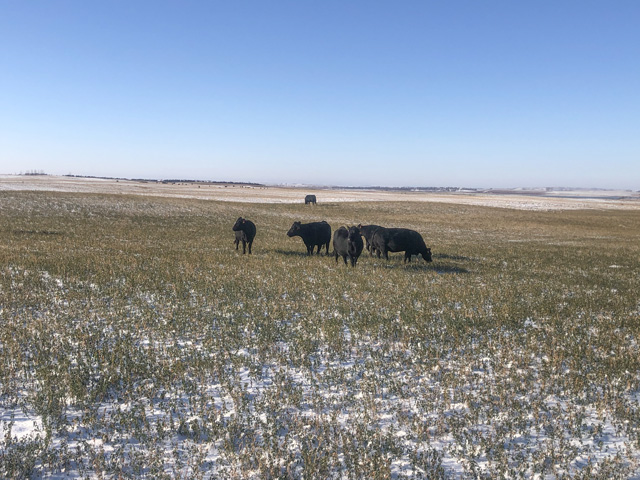Graze Alfalfa Sensibly in Fall, Winter
Alfalfa Can Provide Supplemental Forage, But Additional Management Needed
OMAHA (DTN) -- Cow-calf producer Garrett Wolf allows his cattle to graze alfalfa from late-November until roughly mid-January.
"It's the most efficient way to take off second-cut (alfalfa), in my opinion," Wolf, from Spruce View, Alberta, Canada, told DTN.
Alfalfa stands can provide supplemental forage for cattle in the fall and winter. The practice does carry some risk of bloat problems and damaging alfalfa stands, but additional management can help to resolve these potential issues.
GRAZE WITH CAUTION
Late-season grazing of alfalfa and alfalfa/grass hay stands is a common practice used by livestock producers, according to Kevin Sedivec, North Dakota State University (NDSU) Extension Rangeland specialist and interim director of the NDSU Central Grasslands Research Extension Center located in Streeter, North Dakota. Many livestock producers graze alfalfa residue in the fall following a killing freeze, as it is a cheap, high-quality feed source.
This is a common practice in most of the Dakotas, northern Minnesota, Montana and southern Canada, he said. These areas only get one to two cuttings a year due to their drier environments. Thus, regrowth can be good, but not enough to justify a cutting.
There are, however, some risks producers need to be aware of and precautions that need to be followed when grazing alfalfa and alfalfa/grass hay stands, Sedivec said.
Grazing alfalfa can be toxic to cattle, sheep and other ruminant animals, as live alfalfa plants with moisture on the leaves will cause bloat (a build-up of gas) in all ruminant animals. Death is common with severe bloat cases.
Sedivec said another potential issue with grazing in the fall and winter is the effect of overgrazing on alfalfa stands. Stands can be reduced by winterkill, as alfalfa residue plays an important role in catching snow, which protects the crown root from the cold and potential death.
On the plus side, alfalfa residue is high in protein and energy compared to most other crop residue plants, he said. Crude protein is usually greater than 13%, and total digestible nutrients (TDN) are greater than 60%. Both levels are greater than the requirements of a lactating cow with a calf; a dry, pregnant cow; yearling cattle; and dry, pregnant sheep.
P[L1] D[0x0] M[300x250] OOP[F] ADUNIT[] T[]
In addition to providing a forage with high nutrients, grazing alfalfa reduces the overall feeding costs during the winter feeding period. The longer livestock can graze into fall and winter, the cheaper winter feed costs become, he said.
MANAGEMENT STRATEGIES HELP
Sedivec said there are certain management practices producers can utilize to reduce the risk associated with grazing alfalfa in fall and winter.
At the top of the list is to wait seven to 10 days after a killing freeze before grazing. Producers should assess the stand and look for dead aboveground plant tissue, which dramatically reduces the risk of bloat.
"If perennial cool-season grasses are part of the stand, there is no toxic risk to livestock from the grass," Sedivec said.
Sedivec also recommends enough residual material be left to collect snow for alfalfa crown root protection. About 4 inches of stubble should be left for new alfalfa stands, and as the stand ages, 6 inches of stubble should be left.
Producers will also need to monitor the effects of grazing regularly to assure overgrazing does not occur, he said. Fresh water should always be available to livestock, and wind protection should be available in case of cold, wet and windy conditions.
Wolf, the Alberta cow-calf producer, said he has really never had any issues grazing his cattle on alfalfa in the fall and winter. His cattle are coming off grazing decent stands of grass, so they are usually full, limiting bloat concerns, he said.
Usually by November in his home region of west-central Alberta, there is enough snow on the ground that cows have to work to find the alfalfa. There are usually other grasses with the alfalfa that help to balance out the grazing, he said.
"There is a fair bit of second-cut swaths sitting under 6 inches of snow as we speak," he said.
UNL: CATTLE GAIN GRAZING ALFALFA
A news release titled "Grazing Alfalfa in Fall or Winter" by University of Nebraska-Lincoln (UNL) Extension said studies conducted by UNL show yearling cattle can have 1.5 to 2.5 pounds per day of average daily gain (ADG) grazing alfalfa. Cows can also increase their body condition score before the harsh winter months.
UNL Extension recommends producers graze using a rotation so animals are less selective and are less likely to overgraze a given area.
"Because grazing can leave more growth behind, properly managed grazing may allow plants to better winterize than a late hay cutting, but is still risk for the stand," the release said.
Once the ground is frozen, the danger of hoof damage to alfalfa crowns is reduced. However, producers are reminded to keep an eye out for warm periods where the upper soil layers may thaw and the crowns once again become vulnerable.
Some supplements also can be fed to livestock to prevent bloating, according to the release.
Nonionic surfactants (vegetable fats and mineral oils) reduce rumen foam production, while anti-foaming agents such as poloxalene (typically found in a "bloat block") can be fed to livestock. These products can be successful but depend on regular daily intake to maintain effectiveness, the release said.
To read the entire UNL Extension press release, click on the following link: https://beef.unl.edu/….
Russ Quinn can be reached at russ.quinn@dtn.com
Follow him on Twitter @RussQuinnDTN
(c) Copyright 2020 DTN, LLC. All rights reserved.





